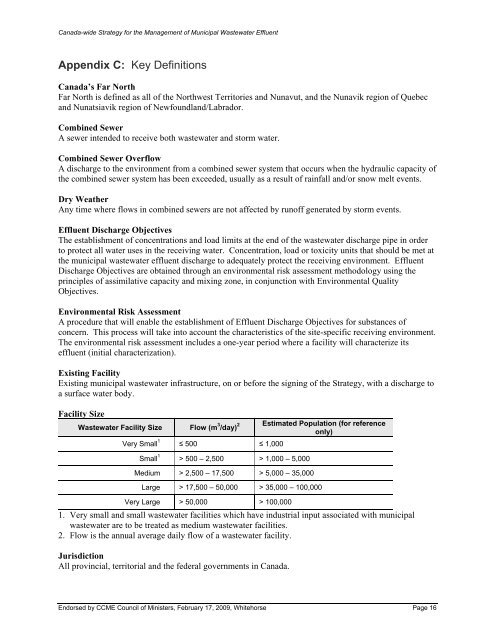Canada-wide Strategy for the Management of Municipal ... - CCME
Canada-wide Strategy for the Management of Municipal ... - CCME
Canada-wide Strategy for the Management of Municipal ... - CCME
Create successful ePaper yourself
Turn your PDF publications into a flip-book with our unique Google optimized e-Paper software.
<strong>Canada</strong>-<strong>wide</strong> <strong>Strategy</strong> <strong>for</strong> <strong>the</strong> <strong>Management</strong> <strong>of</strong> <strong>Municipal</strong> Wastewater Effluent<br />
Appendix C: Key Definitions<br />
<strong>Canada</strong>’s Far North<br />
Far North is defined as all <strong>of</strong> <strong>the</strong> Northwest Territories and Nunavut, and <strong>the</strong> Nunavik region <strong>of</strong> Quebec<br />
and Nunatsiavik region <strong>of</strong> Newfoundland/Labrador.<br />
Combined Sewer<br />
A sewer intended to receive both wastewater and storm water.<br />
Combined Sewer Overflow<br />
A discharge to <strong>the</strong> environment from a combined sewer system that occurs when <strong>the</strong> hydraulic capacity <strong>of</strong><br />
<strong>the</strong> combined sewer system has been exceeded, usually as a result <strong>of</strong> rainfall and/or snow melt events.<br />
Dry Wea<strong>the</strong>r<br />
Any time where flows in combined sewers are not affected by run<strong>of</strong>f generated by storm events.<br />
Effluent Discharge Objectives<br />
The establishment <strong>of</strong> concentrations and load limits at <strong>the</strong> end <strong>of</strong> <strong>the</strong> wastewater discharge pipe in order<br />
to protect all water uses in <strong>the</strong> receiving water. Concentration, load or toxicity units that should be met at<br />
<strong>the</strong> municipal wastewater effluent discharge to adequately protect <strong>the</strong> receiving environment. Effluent<br />
Discharge Objectives are obtained through an environmental risk assessment methodology using <strong>the</strong><br />
principles <strong>of</strong> assimilative capacity and mixing zone, in conjunction with Environmental Quality<br />
Objectives.<br />
Environmental Risk Assessment<br />
A procedure that will enable <strong>the</strong> establishment <strong>of</strong> Effluent Discharge Objectives <strong>for</strong> substances <strong>of</strong><br />
concern. This process will take into account <strong>the</strong> characteristics <strong>of</strong> <strong>the</strong> site-specific receiving environment.<br />
The environmental risk assessment includes a one-year period where a facility will characterize its<br />
effluent (initial characterization).<br />
Existing Facility<br />
Existing municipal wastewater infrastructure, on or be<strong>for</strong>e <strong>the</strong> signing <strong>of</strong> <strong>the</strong> <strong>Strategy</strong>, with a discharge to<br />
a surface water body.<br />
Facility Size<br />
Wastewater Facility Size Flow (m 3 2 Estimated Population (<strong>for</strong> reference<br />
/day)<br />
only)<br />
Very Small 1 ≤ 500 ≤ 1,000<br />
Small 1 > 500 – 2,500 > 1,000 – 5,000<br />
Medium > 2,500 – 17,500 > 5,000 – 35,000<br />
Large > 17,500 – 50,000 > 35,000 – 100,000<br />
Very Large > 50,000 > 100,000<br />
1. Very small and small wastewater facilities which have industrial input associated with municipal<br />
wastewater are to be treated as medium wastewater facilities.<br />
2. Flow is <strong>the</strong> annual average daily flow <strong>of</strong> a wastewater facility.<br />
Jurisdiction<br />
All provincial, territorial and <strong>the</strong> federal governments in <strong>Canada</strong>.<br />
Endorsed by <strong>CCME</strong> Council <strong>of</strong> Ministers, February 17, 2009, Whitehorse Page 16
















